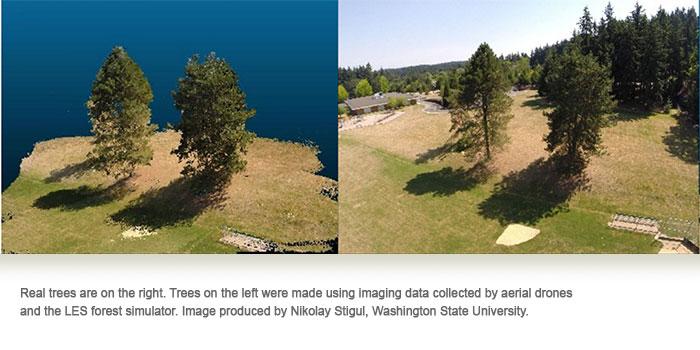

Forestry has increasingly become high-tech, and one of my favorite things is to discover one of the new high-tech forestry tools available to make our work easier, more interesting and more effective.
An esteemed colleague shared with me an article published by Washington State University that highlights one of the coolest tools yet. WSU researchers Nikolay Strigul and Jean Lienard have created a computer simulation that models forests down to leaves, branches and roots of individual trees. They are using the model to understand how forests respond to climate change, including drought, warmer temperatures and increased wildfire activity.
The model uses a mixture of data from the U.S. Forest Service’s Forest Inventory and Analysis Program and aerial photos from drones to develop 3-D models of forests that are very realistic. The photo below shows real trees on the right and simulated trees on the left:

The modeling program is named LES, after the Russian word for forest. The advantage of using a very realistic model such as LES is that it can “grow” forests for several decades to examine the effects of drought, climate change and wildfire. LES is unique because it can grow both the canopies of trees and their root systems. The program also follows individual trees as they grow and respond to different situations.
Foresters have used visualization software such as Stand Visualization Software, or SVS, for many years to generate images showing stand conditions with a list of individual components, including trees, shrubs and down material (example SVS image 67k). The images produced by SVS, while abstract, provide a readily understood representation of stand conditions.
Foresters also have been combining SVS images with forest growth models such as a Forest Vegetation Simulator, or FVS, to simulate and graphically show how forests change over time.
I think LES takes forest visualization and growth to a new level by combining both root and canopy growth with realistic images. LES should be able to give accurate growth estimates in a variety of scenarios and provide extremely realistic images of the forest, which will make it an excellent communication tool.
My March blog was about using visual management tools to make forest harvest more visually appealing. I believe LES could easily be developed into a visual management tool. Go Cougs!
For the Forest,
Mike Cloughesy
Director of Forestry